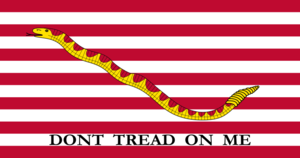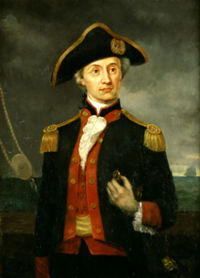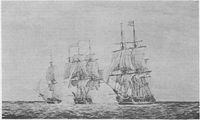American Revolution, naval history
The Continental Navy was the principal naval branch of the Armed Forces of the United States during the American Revolution, formed in 1775. The main purposes of the navy was to provide limited coastal defense and interdiction of British war materiel as well as the disruption of British maritime commercial operations.
The Continental Navy suffered throughout its existence from a lack of funding, resources, and qualified officers and personnel, the resolutions to increase such having fallen prey to interstate politics within the Continental Congress. The initial fleet consisted of converted merchantmen, with exclusively-designed warships being built later in the conflict. Of the vessels that successfully made it to sea, their success was rare and the effort contributed little to the overall outcome of the rebellion.
The embryonic fleet did serve to highlight Continental competency at naval warfare, notably Captain John Paul Jones' raids of British Territorial waters in the later stages of the war.
Congressional Oversight of Construction
The original intent was to intercept the supply of arms and provisions to British soldiers, who had placed Boston under martial law. George Washington had already informed Congress that he had assumed command of several ships for this purpose, and individual governments of various colonies had outfitted their own warships. The first formal movement for a navy came from Rhode Island, whose State Assembly passed on August 26, 1775, a resolution instructing its delegates to Congress to introduce legislation calling "for building at the Continental expense a fleet of sufficient force, for the protection of these colonies, and for employing them in such a manner and places as will most effectively annoy our enemies..." The measure in the Continental Congress was met with much derision, especially on the part of Maryland delegate Samuel Chase who exclaimed it to be "the maddest idea in the world." John Adams later recalled, "The opposition...was very loud and vehement. It was...represented as the most wild, visionary, mad project that had ever been imagined. It was an infant taking a mad bull by his horns."
But during this time, the issue arose of Quebec-bound British supply ships carrying desperately needed provisions that could otherwise benefit the Continental Army. The Continental Congress appointed John Adams, Silas Deane, and John Langdon to draft a plan to seize ships from the convoy in question.
On October 13, 1775, Congress authorized the building of the first vessels of the Continental Navy, literally the birth of the US Navy as it is considered officially.
By the end of October, Congress authorized the purchase and outfitting of four armed vessels. Soon a Naval Committee was formed which quickly purchased merchantmen and oversaw their proper outfitting and readying for combat. Regulations were drafted by John Adams and adopted November 28, 1775. When it came to selecting commanders for ships, Congress tended to be split evenly between merit and patronage. Among those who were selected for political reasons were Esek Hopkins, Dudley Saltonstall, and Esek Hopkins' son, John Burroughs Hopkins. However, Abraham Whipple, Nicholas Biddle, and John Paul Jones managed to be appointed with backgrounds in marine warfare.
On December 3, the Alfred (24), Andrew Doria (14), Cabot (14), and Columbus (24) were commissioned. On December 22, 1775, Esek Hopkins was appointed the naval commander-in-chief, and officers of the navy were commissioned. With this small fleet, complemented by the Providence (12), and Wasp (8), and Hornet (10), Hopkins led the first major naval action of the Continental Navy, in early March 1776, against Nassau, Bahamas, where stores of much-needed gunpowder were seized for the use of the Continental Army. However, success was diluted with the appearance of disease spreading from ship to ship. On 6 April, 1776 the squadron, with the addition of the Fly (8) unsuccessfully encountered the 20-gun HMS Glasgow in the first major sea battle of the Continental Navy. Hopkins failed to give any substantive orders other than the order to recall the fleet from the engagement, a move which Captain Nicholas Biddle described as, "away we all went helter, skelter, one flying here, another there."
The Thirteen Frigates
By December 13th, 1775 Congress had authorized the addition of 13 frigates to the fleet, which were constructed as warships, rather than refitted merchantmen. Of the eight frigates that made it to sea - five were destroyed to prevent capture before carrying out any missions - all were captured or sunk.
Guarding American commerce and raiding British commerce and supply were the principal duties of the Continental Navy. Much of its accomplishments is recorded as prizes taken in commerce raiding, which, as was the practice of the time, brought personal gain to officers and crew.
Most of the thirteen frigates took multiple prizes and had semi-successful cruises before their captures, however there were exceptions. On 27 September 1775, Delaware participated in a delaying action on the Delaware River against the British army pursuing George Washington's forces. The ebb tide arrived and left the Delaware stranded, leading to her capture.
Hancock managed to capture two merchantmen as well as the Royal Navy vessel Fox. Later on 8 July 1777, however, the Hancock was captured by HMS Rainbow of a pursuing squadron.
Randolph took five prizes in her early cruises. In early 1778, she was escorting a convoy of merchantmen when the British 64-gun ship Yarmouth bore down on the convoy. Randolph, under the command of Captain Nicholas Biddle came to the defense of the merchantmen and engaged the heavily superior foe. In the ensuing engagement, the two ships were both severely manhandled but in the course of the action, the magazine of the Randolph exploded causing the destruction of the entire vessel. The falling debris from the explosion severely damaged the Yarmouth enough that she could no longer pursue the American ships.
Virginia made a number of unsuccessful attempts to break through the blockade of Chesapeake Bay. On 31 March, 1778, in another attempt, she was run aground near Hampton Roads. Shortly after, Emerald and Conqueror appeared on the scene to accept her surrender.
Raleigh captured three prizes before being run aground in action on 27 September, 1778. Her crew scuttled her, but she was raised by the British who refloated her for further use in the name of the Crown.
Providence had captured 14 prizes in earlier cruises. However she (along with the Boston who had taken 17 prizes in her own service) was captured in the fall of Charleston, South Carolina on 12 May, 1780.
The final frigate to meet her end of Continental service was the Trumbull. Trumbull had gained acclaim in bloody action against the Letter of Marque Watt. On 28 August, 1781, she met HMS Iris and General Monk and engaged. In the action, Trumbull was forced to surrender. Ironically, the Iris was the former Continental frigate Hancock while the General Monk was the captured General Washington.
Before the Franco-American Alliance, the royalist French government attempted to maintain a state of respectful neutrality during the Revolutionary War. That being said, the nation maintained neutrality at face value, often openly harboring Continental vessels and supplying to their needs.
With the presence of American diplomats Benjamin Franklin and Silas Deane, the Continental Navy gained a permanent link to French affairs. Through Franklin and likeminded agents, Continental officers were afforded the ability to receive commissions, survey, and purchase prospective ships for military use.
Early in the conflict, Captains Lambert Wickes and Gustavus Conyngham operated out of various French ports for the purpose of commerce raiding. The French did attempt to enforce her neutrality by seizing Dolphin and Surprise. However, with the commencement of the official alliance in 1778, ports were officially open to Continental ships.
The most prominent Continental officer to operate out of France was Captain John Paul Jones. Jones had been preying upon British commerce aboard the Ranger but only now saw the opportunity for higher command. The French loaned Jones the merchantman, Duc de Duras, which Jones refitted and renamed Bonhomme Richard as a more powerful replacement for the Ranger. In August 1779, Jones was given command of a squadron of vessels of both American and French ownership. The goal was not only to harass British commerce but also to prospectively land 1500 French regulars in the lightly guarded western regions of Britain. Unfortunately for the ambitious Jones, the French pulled out of the agreement pertaining to an invasion force, but the French did manage to uphold the plan regarding his command of the naval squadron. Sailing in a clockwise fashion around Ireland and down the east coast of Britain, the squadron captured a number of merchantmen. The French commander Landais decided early on in the expedition to retain control of the French ships, thereby often leaving and rejoining the effort when he felt it was fortuitous.
On 23 September, 1779, Jone's squadron was off Flamborough Head when the British men-of-war Countess of Scarborough and Serapis bore down on the Franco-American force. The lone Continental frigate, Bonhomme Richard engaged the Serapis. In a particularly bloody, destructive fight, the English captain called out to inquire if the Bonhomme Richard had struck her colors. Jones cried out, "I have not yet begun to fight!" Upon raking the Serapis, the crew of the Bonhomme Richard led by Jones boarded the English ship and captured her. Likewise, the French frigate Pallas captured her prize the Countess of Scarborough. Two days later, the Bonhomme Richard sank from the overwhelming amount of shock she took from the struggle.
The action stuck out as an embarrassing defeat for the Royal Navy, who suffered the capture of two of her vessels in her own home waters.
In a like fashion, the French loaned the Continental Navy the use of the corvette Ariel. The one ship of the line built for service in the Continental Navy, the 74-gun America, was instead offered to France as compensation for the loss of its Le Magnifique, lost in service to the American Revolution.
With the close of the war, Congress was desperate for funds to run the new, fledgling nation. In response to the financial crisis, Congress considered ending the Continental Navy's existence. One of the justifying factors was the insistence that an extended US Navy would only serve to involve America in conflicts it had no service in being a part of. Furthermore, the cost of maintaining a standing navy in addition to operating costs severely drained what little funds the Congress had to begin with.
On 1 August, 1785, the financially strapped Congress auctioned off the last remaining Continental Navy vessel, USS Alliance for $26,000.
The Continental Navy saw defeat in almost every venture it undertook. Of all of its vessels, only a handful made it through the war without having been destroyed, sunk, or captured. The Continental Navy posed no significant threat to Royal Navy supremacy and did little to alter the course of the war.
The Continental Navy did, however, keep American morale and spirit up as the war progressed, adding to the hope that one day the 13 Colonies would emerge successful from their struggle.
See also
References
- William M. Fowler, Rebels Under Sail (New York: Charles Scribner's Sons, 1976)
- Nathan Miller, The US Navy: An Illustrated History (New York: American Heritage, 1977)
- Naval Documents of the American Revolution (Government Printing Office, 1964-). 10 volumes of primary sources.




